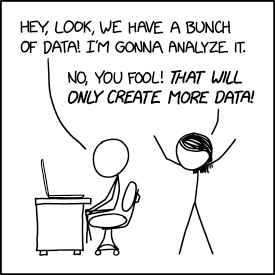Photo by Alex Kondratiev on Unsplash
07 July, 2022
Integrated lab solutions
Modern lab requirements
- High throughput of samples
- Multiple parameters
- Many (partly-)automatized techniques
- Software and computer systems
- Multifaceted and large data streams
A 2020 study of my own: atomic absorption spectroscopy, atomic emission spectroscopy, mass spectrometry, scanning electron microscopy, spectrophotometry, energy-dispersive X-ray spectroscopy, elemental analyser, and high-sensitive balance
Taking command of lab-data
- Default commercial software (Cameca, Zeiss, Thermo Fisher)
- Prevent tracking data from source to publication
- Fragmented storage
- Monitoring and troubleshooting is reduced to current analysis
Vendor lock-in
Opening-up the black box of lab-data
- GUI based dashboards, wizards and dialogs that hide (part) of the transformations and calculations taking place
- The reviewer that wants to trace back the origin of data
- Old/defunct machinery
Is more data better?
- New innovations
- Inclusive science
- More transparent science (proof of final published values)

The integrated lab
- Data collecting and harmonization
- Parsing of unstructured data
- Data normalization (SQL-like)
- Modular processing, analysis, and diagnostics suite
- Count statistics, spectral analysis, regression, …
- Online monitoring
- Dashboards of the lab’s long-term reproducibility
- Troubleshooting
The integrated lab
- Data collecting and harmonization
- Parsing of unstructured (meta)data
- Data normalization (SQL-like)
- Modular processing, analysis, and diagnostics suite
- Count statistics, spectral analysis, regression, …
- Online monitoring
- Dashboards of the lab’s long-term reproducibility
- Troubleshooting
Data collecting and harmonization
Custom solutions
- Deciphering the vendor’s data-model is labor intensive
- Multiple files
- Many observations
- Inconsistent syntax
- Unstructured
- Accommodate vendor’s software/data-model updates
An universal solution?
Parsing lab-data
Text data (encoded or decoded)
Unstructured raw data files from analytical laboratory
Proposed solutions
Three possible solutions, which require varying degrees of human intervention:
- A mechanism to aid the location of variables based on user input
- A human-crafted (and adaptable) rule based system
- A natural language processing approach involving self-supervised machine learning
The last two solutions would be preceded by a step entailing text normalization through tokenization.
iRODS and user accesibility
Integration with iRODS
- Sub-system for automated ingest
- Automated workflows
- Better collaboration
Accessibility
- Interfaces for R and Python (standalone usage)
Evan-Amos, 2011. A SanDisk Cruzer USB drive from 2011, with 4 GB of storage capacity Wikipedia
Implementation
panacea: Portable ANalytical data Aggregation and Coordination for database Entry and Access
- C++ for optimal performance with large datasets
- R and python bindings for user-friendliness and standalone usage
auxiliary
- Updating rirods (irods/irods_client_library_r_cpp) to work with iRODS from R
- Restrictive and complex system requirements not ideal for R and C++ integration
Roadmap
Long-term goals
The integrated lab will foster:
- more efficient labs and innovations
- better open science practices
- inclusive science
Stimulate a push in the industry of lab equipment towards open sourced software solutions
FAIReLABS
Help us! https://fairelabs.github.io/webpage/